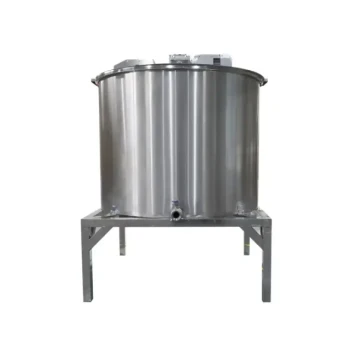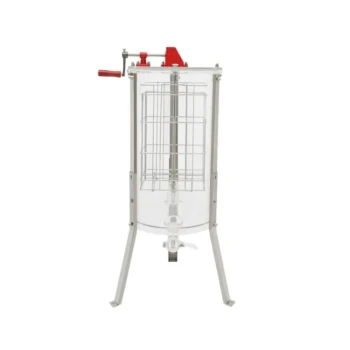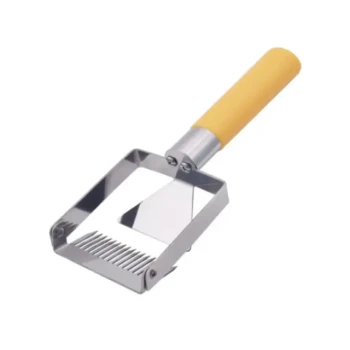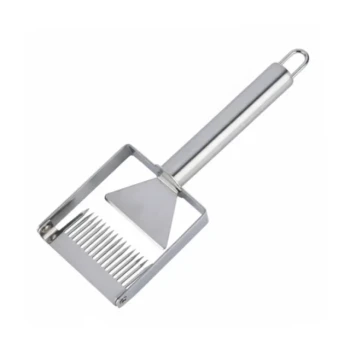At its core, beekeeping equipment is defined by its mechanical function. The three basic types of honey extractors are tangential, radial, and the less common parallel radial. These types are differentiated by how they position the honeycomb frames inside the drum, which dictates the efficiency and scale of your honey harvesting process.
The fundamental choice you face is not about brand or power source, but about mechanical design. A tangential extractor extracts honey from one side of the comb at a time, requiring you to flip the frames, while a radial extractor extracts from both sides simultaneously, saving significant time and labor.
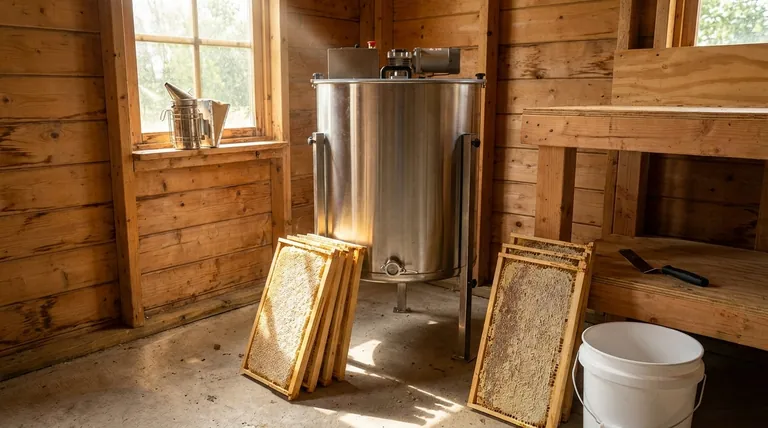
The Fundamental Difference: How Frames Are Positioned
The "type" of an extractor refers to the orientation of the frames relative to the force of the spin. This single design choice has the biggest impact on your workflow.
Tangential Extractors: One Side at a Time
In a tangential extractor, the frames are placed with the wide, flat side of the comb facing outwards, sitting flush against the inner wall of the drum.
This means that when you spin the drum, centrifugal force only pulls honey from the outer-facing side of the comb. To extract all the honey, you must stop the process, manually flip each frame, and spin them a second time.
These units are typically smaller, holding between two and six frames, and represent the most common entry-point for new beekeepers.
Radial Extractors: Both Sides Simultaneously
In a radial extractor, frames are loaded like the spokes of a wheel, with the top bar of the frame facing the outer wall.
As the extractor spins, centrifugal force is applied equally to both sides of the comb, pulling honey from both sides at the same time. This design eliminates the need to flip the frames, drastically reducing processing time.
Radial extractors are built for efficiency and scale, with capacities ranging from four to over one hundred frames.
Parallel Radial Extractors: A Specialized Variation
The parallel radial is a third, less common design that modifies the radial principle. While the references do not detail its specific mechanics, it is a variation of the radial design aimed at optimizing capacity for certain frame sizes within a specific drum diameter.
For most beekeepers, the primary decision remains between the standard tangential and radial designs.
A Separate Decision: Manual vs. Motorized Power
A common point of confusion is categorizing "manual" as a type of extractor. The power source is an independent feature from the extraction method. Both tangential and radial extractors can be either manual or motorized.
Manual Extractors (Hand-Crank)
Manual extractors use a hand-crank to generate the spinning motion. They are mechanically simple, less expensive, and do not require a power source, making them ideal for harvesting in remote locations. Their main drawback is the physical labor required.
Motorized Extractors (Electric)
Motorized extractors use an electric motor to spin the basket, often with variable speed controls. This automates the most labor-intensive part of the process, saving enormous amounts of time and effort, which is essential for any beekeeper with more than a few hives.
Understanding the Trade-offs
Choosing an extractor involves balancing cost, efficiency, and the scale of your operation.
Efficiency vs. Cost
A tangential extractor has a lower initial cost, making it an attractive option for beginners. However, the time spent flipping frames adds up quickly during a harvest.
A radial extractor is a larger upfront investment but provides a significant return in time and labor savings, making it more cost-effective in the long run for growing apiaries.
Frame Capacity and Scalability
Tangential extractors are perfectly suited for hobbyists with one to three hives. Their smaller capacity (typically 2-4 frames) aligns well with a small-scale harvest.
Radial extractors are the clear choice for beekeepers with four or more hives or for anyone who plans to expand. Their larger capacity and higher efficiency are necessary to manage larger harvests without excessive effort.
Risk of Comb Damage
In a tangential extractor, the full force of the spin is applied to one side of the comb. If you spin too fast too soon, the weight of the honey can blow out the wax foundation.
Radial extractors apply force more evenly across the frame's structure, reducing the risk of "blowouts" and allowing for a more forgiving extraction process.
Making the Right Choice for Your Apiary
Your decision should be guided by the current size and future goals of your apiary.
- If you are a hobbyist with 1-3 hives: A small manual tangential extractor is the most cost-effective and practical starting point.
- If you have 4+ hives or plan to expand: Investing in a radial extractor will save you significant time and labor as your operation grows.
- If your primary focus is minimizing physical effort: A motorized extractor is the clear choice, whether it is a tangential or radial model.
Understanding these core differences empowers you to select the right tool that aligns with your specific beekeeping goals.
Summary Table:
| Type | Frame Orientation | Key Characteristic | Ideal For |
|---|---|---|---|
| Tangential | Frames against the drum wall | Extract one side at a time; frames must be flipped | Hobbyists (1-3 hives); low initial cost |
| Radial | Frames like wheel spokes | Extract both sides simultaneously; no flipping needed | Beekeepers with 4+ hives; efficiency and scalability |
| Parallel Radial | Variation of radial design | Optimizes capacity for specific frame sizes | Specialized applications |
Ready to Scale Your Honey Harvesting?
Choosing the right extractor is crucial for your apiary's efficiency and growth. Whether you're a commercial beekeeper needing a high-capacity radial system or a distributor stocking reliable equipment, HONESTBEE supplies the durable, scalable extractors you need.
We provide wholesale-focused solutions for commercial apiaries and beekeeping equipment distributors. Let us help you select the perfect extractor to save time, reduce labor, and maximize your yield.
Contact HONESTBEE today for expert advice and wholesale pricing!
Visual Guide
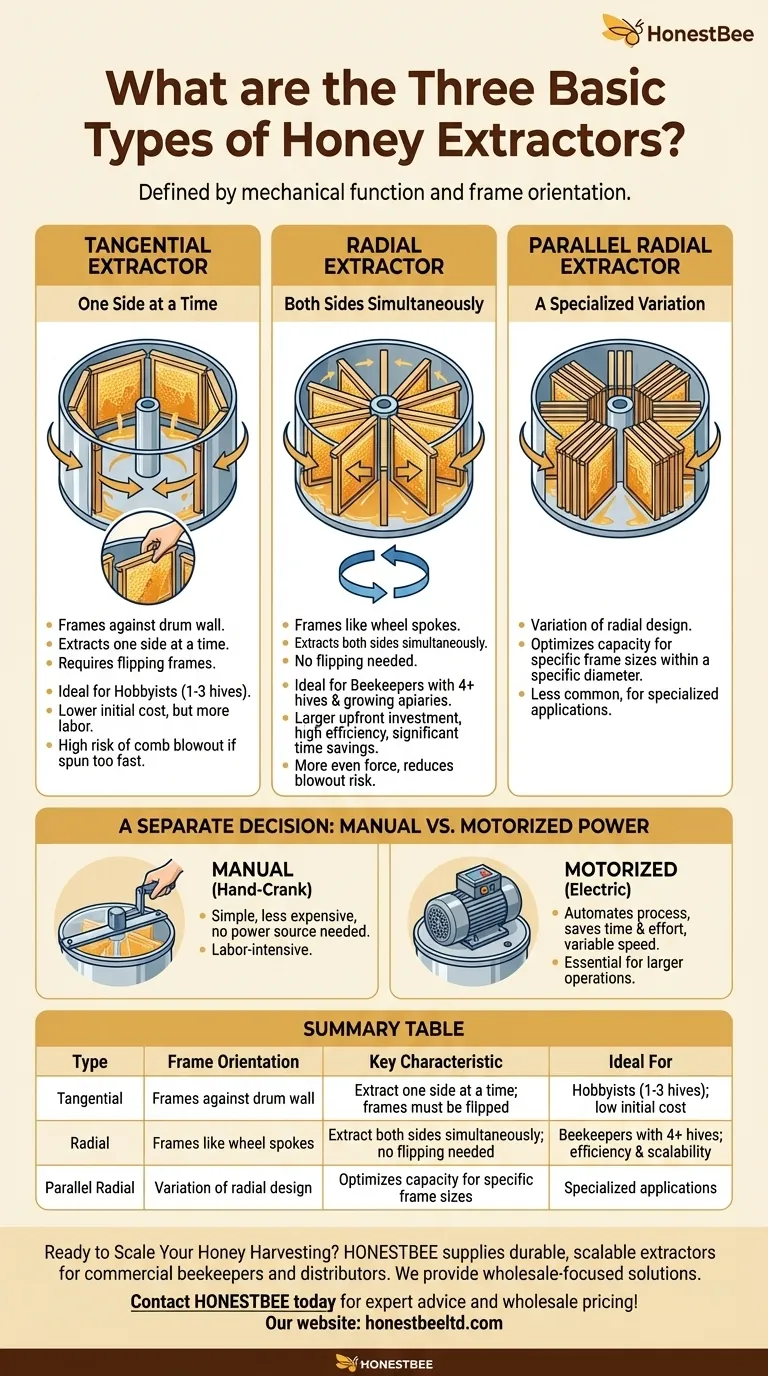
Related Products
- Electric 8 Frame Honey Spinner Extractor Equipment for Beekeeping
- 32 Frame Commercial Electric Honey Extractor for Beekeeping and Honey Production
- HONESTBEE 2 Frame Manual Acrylic Honey Extractor Beekeeping Equipment
- HONESTBEE 72 Frame Industrial Electric Honey Extractor for Beekeeping
- HONESTBEE 3-Frame Manual Acrylic Honey Extractor
People Also Ask
- What should be considered when harvesting honey from multiple hives? Scale Your Harvest Efficiently
- What machines are needed in beekeeping besides basic tools? Scale Your Honey Harvest Efficiently
- Why is cleaning a honey extractor important in beekeeping? Protect Your Honey Quality & Equipment
- What are the differences between manual and electric honey extractors? A Beekeeper's Guide to Power, Speed & Cost
- What equipment is needed for extracting honey? A Complete Guide for Every Beekeeper

